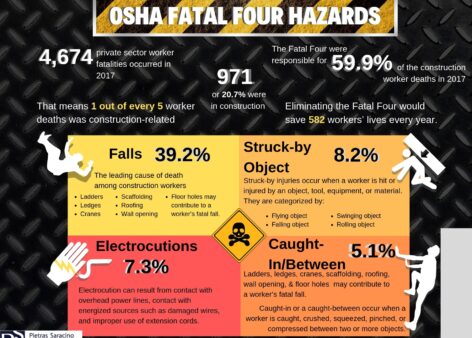
Through the eyes of Project Navigator’s Anthony Vu, this video gives us a peek into his week of 40-hr Hazwoper training. The training was conducted by Environmental Training and Compliance (ETAC) located in Anaheim, CA.
 SafetyMoment
SafetyMoment

Through the eyes of Project Navigator’s Anthony Vu, this video gives us a peek into his week of 40-hr Hazwoper training. The training was conducted by Environmental Training and Compliance (ETAC) located in Anaheim, CA.

Working in the construction industry takes skills and stamina, but no matter how agile and experienced a worker may be, it does not detract from the hazards they may face. Every day new challenges arise that put workers at risk of being hurt or fatally injured on the job. Dangerous elements of a construction job may include the use of heavy equipment or hazardous chemicals, falling objects, and flying debris, or becoming stuck in between machinery or supplies.
The Occupational Safety and Health Administration (OSHA) generated the “Fatal Four” list, which accounts for the most fatal work accidents that may occur in construction or similar industries. It consists of falls, struck by objects, electrocution, and caught-in/between incidents. Falls accounted for nearly 40 percent of workplace accidents in 2017, which makes them the most common. In fact, OSHA ranked fall hazards as the most common violation for seven years running. Being struck by an object, electrocution, and getting caught in or between objects accounts for under ten percent each (eight percent, seven percent, and five percent respectively). Fatal Four-recognized accidents make up around 60 percent of construction accidents per year. Nearly 600 lives could be saved each year if Fatal Four accidents could be prevented altogether.
The South Jersey workers’ compensation lawyers at Pietras Saracino Smith & Meeks, LLP present this infographic that displays the four most fatal construction accidents that fall under OSHA’s Fatal Four and how commonly they take place.
How to Prevent the Fatal Four Accidents
So, what can be done to avoid these accidents and injuries from occurring? Employers and workers can prevent these dangers by taking the following steps.
Source: OSHA Fatal Four Hazards | Learn More About How It Can Affect You (njworkinjuries.com)

Everyone aged 2 years or older—including passengers and workers— should properly wear a well-fitting mask or respirator in indoor areas of public transportation (such as airplanes, trains, buses, ferries) and transportation hubs (such as airports, stations, and seaports), especially in locations that are crowded or poorly ventilated such as airport jetways.
Source: www.cdc.gov